What Is Infinex? The Gasless All In One DeFi Wallet
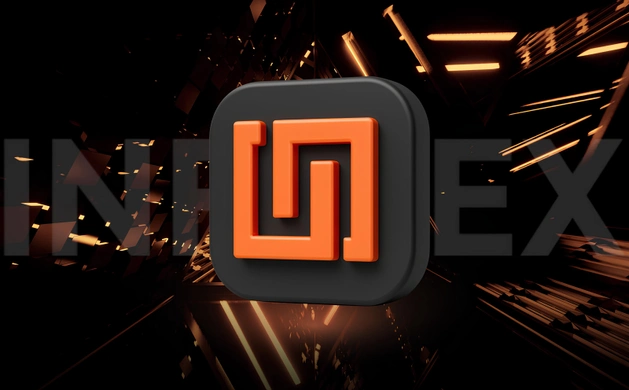
Summary: Infinex is a cross-chain, non-custodial crypto account system (functionally similar to a wallet) that replaces seed phrases and manual transaction signing with passkeys and recoverable smart contracts.
It encodes identity, custody, and execution as onchain logic, distributing influence through Patron NFTs and allocating rewards via Yaprun, scored using Kaito’s mindshare and attribution systems.
Infinex is a cross-chain, non-custodial crypto account that removes seed phrases, gas fees, and wallet fragmentation through passkeys and smart contract accounts.
Supported Networks
Ethereum, Solana, Arbitrum, Base, Optimism, Polygon, BNB Chain
Security Features
Passkey authentication, onchain recovery, smart contract isolation
Fees
No platform fees; gas subsidized for most actions like swaps
What is Infinex?
Infinex is a non-custodial crypto application that lets users access DeFi without managing private keys or worrying about gas fees. It replicates the smoothness of centralized platforms while preserving transparency, self-custody, composability, and permissionless access across networks.
Each Infinex Account includes a passkey-secured Wallet for everyday use and a Vault for long-term storage with programmable recovery. This architecture abstracts away complex actions like transaction signing and bridging across networks while preserving user control and minimizing security risks.
By eliminating reliance on trusted third parties, Infinex becomes a universal UX layer for trading, staking, yield strategies, perpetuals, and cross-chain mobility. The result is a coherent entry point into decentralized finance that prioritizes usability without compromising the principles that define it.
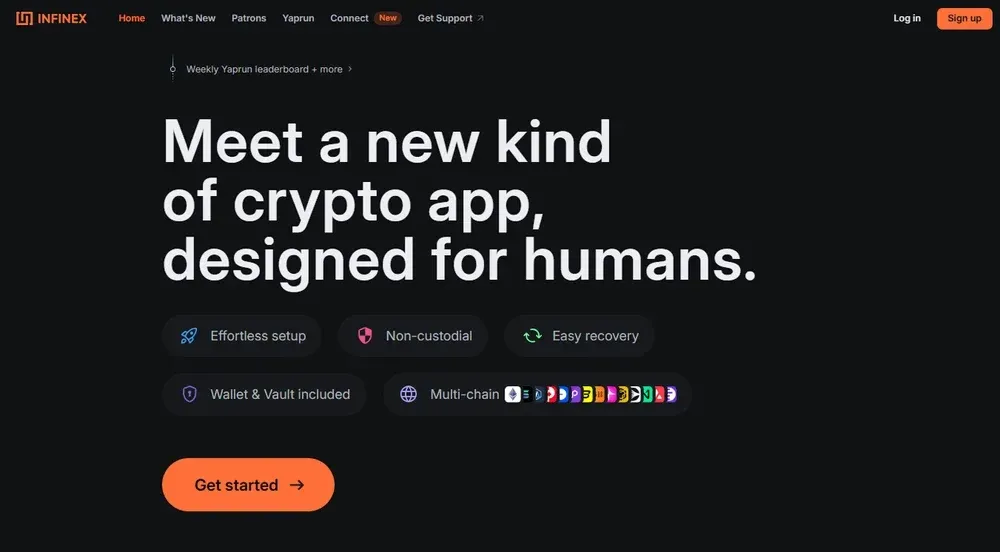
What Can I Do With Infinex?
Infinex enables interaction with onchain protocols across 14 networks, including Ethereum, Solana, Base, and Arbitrum. It presents financial operations through a structured interface that reduces user-side friction while preserving the underlying properties of decentralization.
The top use cases of Infinex include:
- Bridge and swap (Swidge) across chains: Transfer assets between networks using integrated routing that handles liquidity, slippage, and execution without manual configuration or gas.
- Earn protocol-native rewards: Allocate capital to vaults linked to protocols like Lido, Renzo, and Jito, with rewards accruing automatically onchain.
- Access structured derivatives: Trade decentralized perps and synthetics through a unified interface that reflects position state transparently while preserving settlement guarantees.
- Easily Recover Your Lost Account: Configure fallback keys, social recovery, or delegated access through deterministic onchain contracts tied to your account.
- Participate in governed campaigns: Join systems like Speedrun or Craterun to earn governance rights and access, based on contribution rather than capital alone.
For the latest Infinex additions, we recommend looking at the product changelog, which typically includes one update every 1-3 weeks, based on our observation.
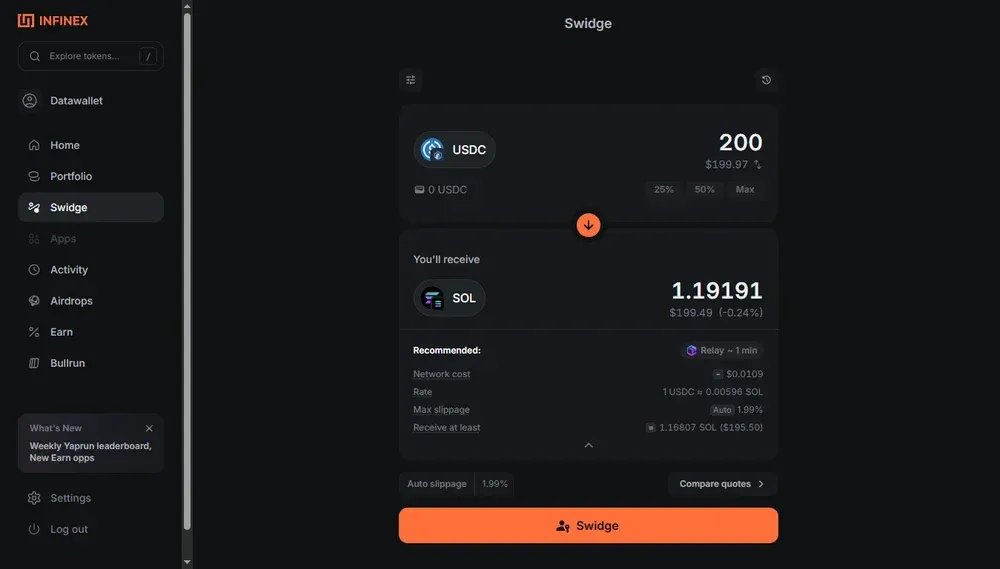
Infinex Accounts Explained
An Infinex account is a smart contract system deployed per chain, enabling onchain interaction without seed phrases or exposed keys. Unlike conventional crypto wallets, it encodes custody, signing, and recovery as contract-defined functions. Think of it as an onchain identity, not just a keypair.
Authentication occurs through passkeys stored on the user’s device, resistant to phishing and inaccessible to both Infinex and its infrastructure providers. This structure reflects a practical form of account abstraction, enabling flexible crosschain coordination while preserving autonomy, auditability, and fault isolation.
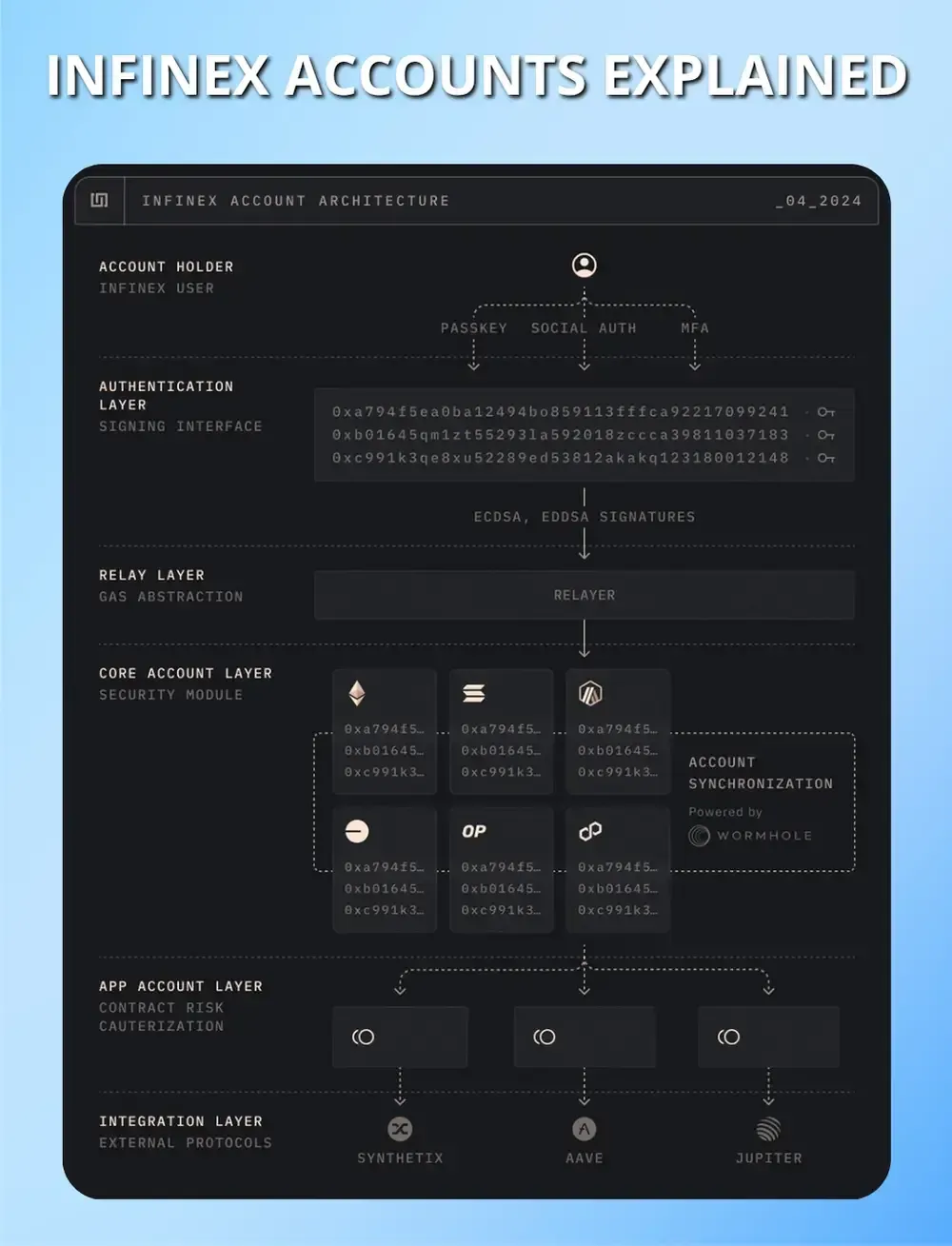
How to Create an Infinex Account
Infinex provides a secure, non-custodial onboarding process that replaces passwords with passkeys, thereby reducing trust assumptions and increasing user control.
We created an account in under two minutes, following these six steps:
- Go to the start page: Visit infinex.xyz/get-started, where you’ll begin the process by choosing a unique username for your account.
- Click “Create Account”: Proceed after reviewing the Terms of Use and Privacy Policy; this will initiate the secure registration and authentication process.
- Select passkey method: Choose to register using a Google account (for quick access) or opt to set up via another device.
- (Optional) Sync to mobile: If using another device, select your platform (iOS or Android) and scan the QR code with your phone’s camera.
- Approve passkey creation: Authenticate using your phone or browser’s biometric, PIN, or security prompt to finalize the passkey setup.
- Enter your account: After authentication, your wallet is automatically deployed; click “Enter” to access the dashboard and begin using Infinex.
Important: Infinx's passkeys replace traditional passwords by generating a cryptographic key pair, where the private key stays on your device and is used to sign login challenges. This approach makes phishing impossible and minimizes reliance on centralized identity systems.
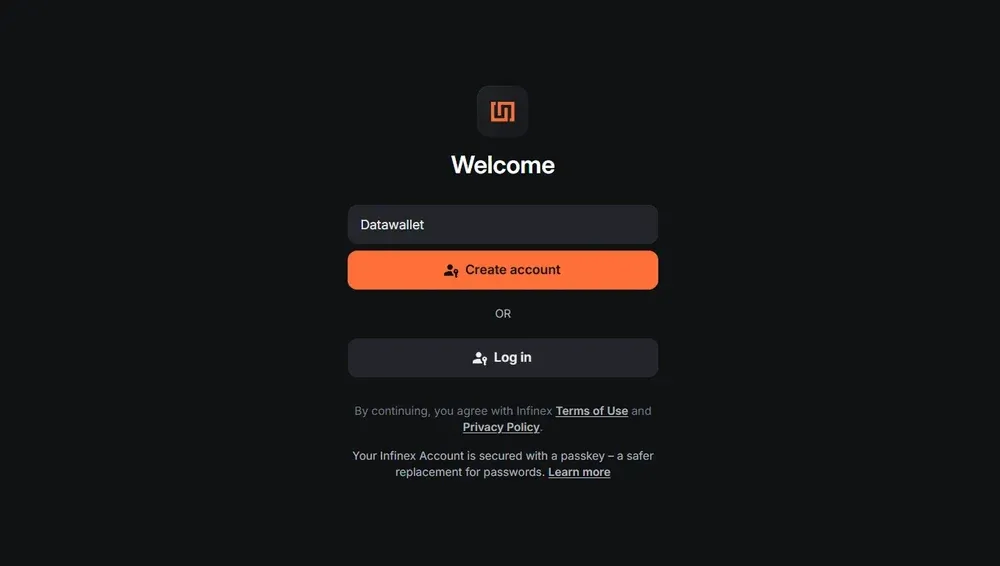
What are Infinex Patrons?
Infinex Patrons are holders of a unique NFT that represents early alignment with the mission to replace centralized exchanges through superior onchain infrastructure.
Rather than raising capital through private seed rounds, Infinex distributed governance and influence directly to users, founders, and funds via the largest public NFT sale in crypto history.
The Patron set includes figures like Vitalik Buterin (Ethereum), Jesse Pollak (Base), Stani Kulechov (AAVE), Toly (Solana), and Mert (Helius), along with foundations such as Founders Fund, Wintermute Ventures, Framework Ventures, and the Near Foundation.
Infinex NFTs confer benefits such as zero-fee trading, early access to features, and participation in governance campaigns, and currently trade on Magic Eden, OpenSea, and Blur with a floor price of 1.22 ETH.
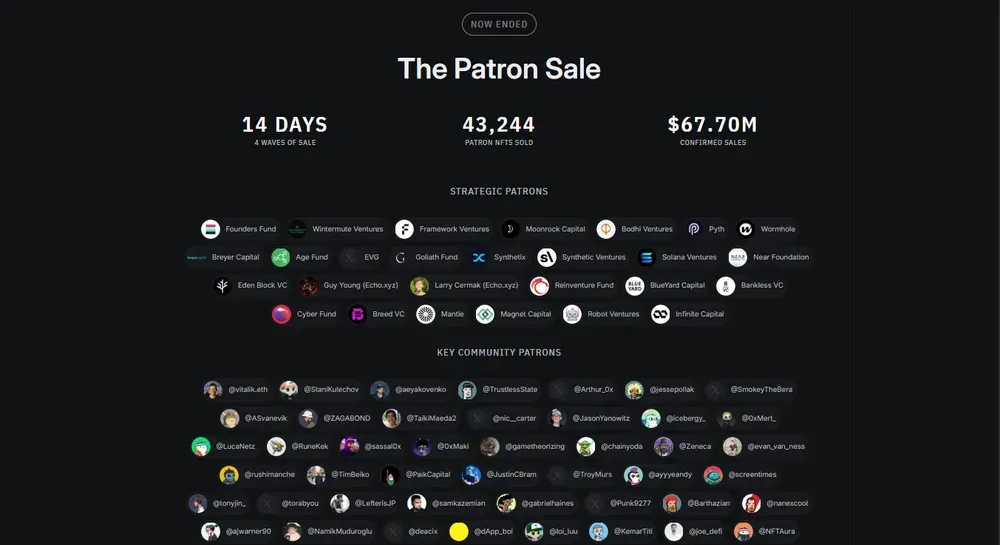
How To Earn Infinex Rewards
Infinex distributes over $6M in rewards through Yaprun airdrops, a multi-season campaign developed in collaboration with Kaito to reward signal, usage, and network reach.
µPatrons (non-transferable units indexed to Patron NFTs) are allocated based on leaderboard performance measured by Kaito’s mindshare data and Infinex’s proprietary scoring system.
Steps to earn Infinex rewards:
- Post thoughtful content: Connect your X account and share original, high-quality material that contributes to Infinex awareness and sustained engagement.
- Refer real users: Drive genuine adoption through unique referral links. Impact is measured by quality of usage, not raw volume or clicks.
- Combine both strategies: Contributions across attention and referrals are scored weekly, with leaderboard rank determining final µPatron allocation.
- Earn µPatrons: At season’s end, rewards are distributed to top participants, as over $900K in µPatrons will be awarded in Season 1 alone.
- Patron NFT holders earn more: Holding a Patron NFT applies a multiplier to your score, boosting leaderboard position and increasing reward share.
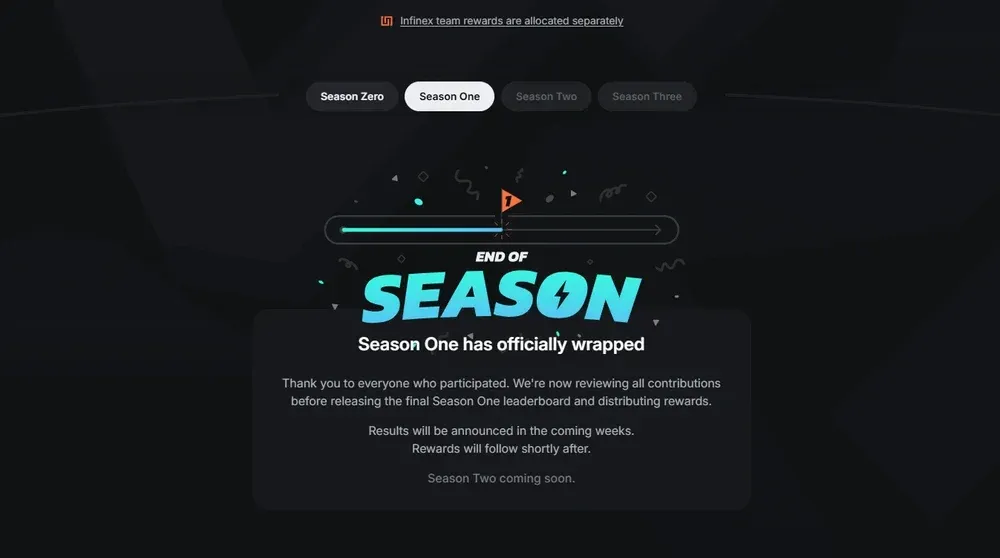
Is Infinex Audited?
Yes, Infinex has undergone extensive review by multiple smart contract auditing companies, including iosiro, macro, and OtterSec. Across more than a dozen audits, CurveStableSwap integrations, and multiple smart account releases, core components have been formally assessed for correctness and security.
As of now, Infinex secures over $447 million in total value locked (TVL) across 14 chains, including $410M on Ethereum and $12.6M on Solana. This level of capital concentration necessitates rigorous security standards, and ongoing audits are embedded into the platform's deployment lifecycle.
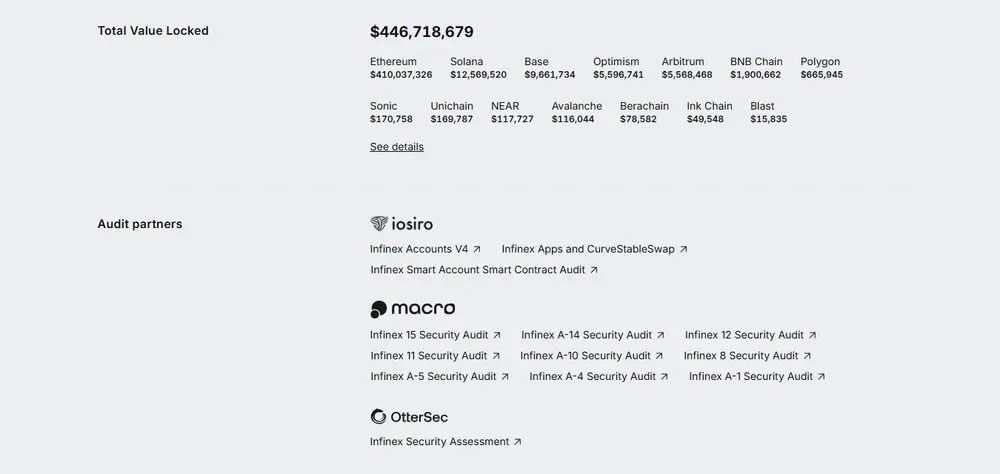
Infinex Risks
It would be very nice if a non-custodial interface eliminated systemic risk entirely, but Infinex, like any protocol, carries design tradeoffs. Some of the more obvious ones include:
- Passkey and recovery misconfiguration: Failing to assign a recovery address or secure backup (e.g. 2FA) creates a single point of failure in the Infinex Account lifecycle.
- Vault-device key compromise: If the device holding your passkey is breached, an attacker may authorize wallet-level actions without triggering recovery protections.
- Protocol integration exposure: Infinex interfaces with external protocols (e.g., Curve, Ethena); vulnerabilities in those contracts may propagate risk downstream to user funds.
- Governance centralization: Patron NFTs and Governance Points enable influence… if concentrated, they risk undermining the system’s trust-minimized trajectory.
- UX layer abstraction failure: While Infinex removes complexity for users, incorrect assumptions about automation or custody may lead to irreversible loss during edge cases.
- Smart contract vulnerabilities: Although audited, Infinex’s contracts remain onchain programs and any exploit at the base layer could compromise account logic or asset flow.
Who Created Infinex?
Infinex was created by Kain Warwick (kain.eth), the founder of the Synthetix protocol: a derivatives platform currently securing over $600 million in TVL. Warwick leads the Infinex Core Working Group, connecting the project to years of protocol development and decentralized market design.
Initially proposed during naming debates around Synthetix’s frontend (which resulted in Kwenta), Infinex returned to address deeper UX barriers. It was built to complement Perps V3 while being governed by SNX token holders, replicating the CEX experience without compromising cryptographic integrity.
Final Thoughts
The largest barriers to using DeFi have never been the protocols themselves, but the interfaces layered on top. Infinex addresses this directly by removing seed phrases, eliminating gas, and abstracting chain boundaries, without reintroducing custodial risk.
If it succeeds, the market need for centralized intermediaries in crypto could be structurally reduced. It would be very nice if that reduction came not through ideology, but through better engineering.
Frequently asked questions
Are there fees on Infinex?
Infinex does not charge platform fees for most actions, and currently subsidizes network fees on Send and Move transactions up to platform-defined limits.
For Swidge, users only pay estimated gas fees, starting from $0.10 on most networks and $5.00 on Ethereum Mainnet, with full gas subsidies granted to Patron NFT holders except when Priority Mode is used.
How do I create an Infinex Account using a hardware (USB) device?
To register with a USB security key, begin account setup and select the option to store your passkey on an external device. You will be prompted to insert the key, create a PIN, and confirm identity by physically touching the device, completing secure registration without using a password or seed phrase.
What’s the difference between the Infinex Wallet and Vault?
The Vault secures assets through onchain smart contracts, supports two-factor authentication, and offers native recovery even if Infinex is offline. The Wallet enables broader protocol interactions with lower friction, supports offchain recovery via verified email, and is required for accessing features like Swidge and staking.
How do I use the Infinex Funds Recovery App?
To recover lost access, request the official Funds Recovery App link through support, authenticate, and confirm the destination recovery address for each asset. Recovery only applies to Vault-held funds on supported networks, is irreversible once triggered, and may take up to one hour to complete.
%25201%2520(1).webp)
Written by
Emily Shin
Research Analyst
Emily is passionate about Web 3 and has dedicated her writing to exploring decentralized finance, NFTs, GameFi, and the broader crypto culture. She excels at breaking down the complexities of these cutting-edge technologies, providing readers with clear and insightful explanations of their transformative power.

.webp)
.webp)
.webp)
%2520(1).webp)

%2520(1).webp)




